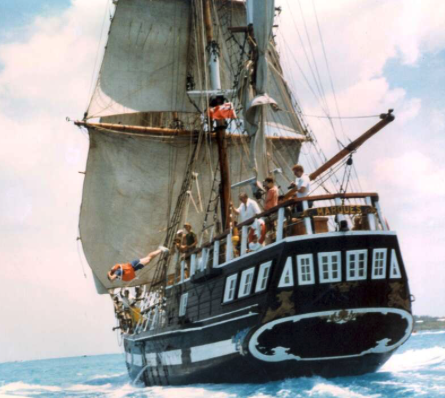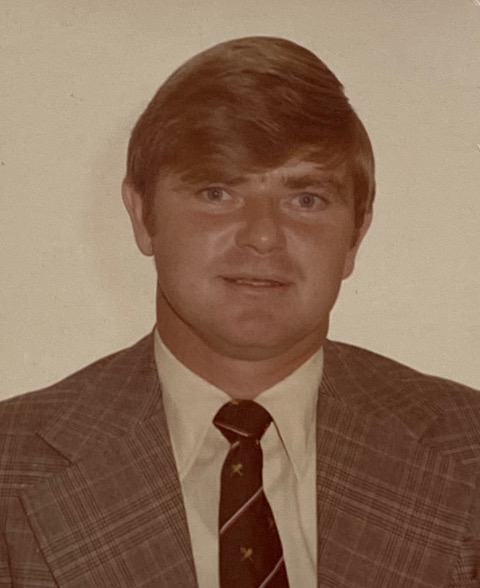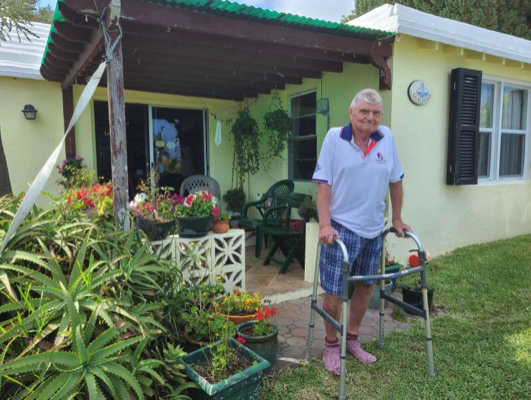 Hours from doom: Bermudian photographer Ann Spurling leaps
Hours from doom: Bermudian photographer Ann Spurling leaps 40 years ago today, 3rd June 2024, Bermuda was the scene of a tragic disaster at sea with the sinking of the tall ship Marques. This morning’s Royal Gazette has published an extensive article written by Sarah Lagan about the tragedy as a result of one of our former colleagues, retired Inspector Dave Barber calling the Gazette to suggest that they consider commemorating the tragedy which the newspaper has duly done with information including documents provided by Dave who was directly involved with the investigation, including having the nine survivors interviewed by the Police to establish all of the circumstances surrounding the loss of the Marques. At the time of this disaster Dave was OIC Western Division.
 Inspector David "Dave" Barber
Inspector David "Dave" Barber
The RG reports, “As the 40th anniversary of the tragic sinking of the tall ship Marques approaches, a former police inspector recalls the first-hand account given to him by one of the young survivors. The chilling moment the tall ship Marques and her crew were sunk by a rogue wave resulting in significant loss of life has been recollected 40 years after the tragedy struck off Bermuda’s waters.
A former police inspector, who interviewed one of the nine survivors at HMS Malabar at the Royal Navy Dockyard, dug out documents and items he kept after disaster struck on June 3, 1984. Among them was a copy of the police statement he took down, The Royal Gazette’s coverage of the event, and a pack of Marques-branded playing cards gifted to him by the first mate.

As the 40th anniversary of one of the island’s biggest news events approaches, Mr Barber said more should be done to commemorate it.
Journalists involved in the reporting of the rescue operation to the world’s media also recounted their experiences.
The British-registered, square-rigged barque set sail from Bermuda as part of the Bermuda-to-Nova Scotia leg of the Cutty Sark Tall Ships Race on Saturday, June 2, 1984.
At about 4am the next day, close to 80 miles north of Bermuda, a freak wave enveloped the vessel.
In as little as 30 seconds, the whole ship went under.
Of the 28 people on board, one body was recovered and 18 others were missing, among them the American captain, Stuart Finlay, his wife, Aloma, and their 15-month-old son, Christopher.
David Barber was among police officers called upon to take down statements from the nine survivors.
He spoke with sail passenger John Morgan Ash, a 23-year-old lifelong sailor who wanted to gain experience on a square-rigger.
Mr Barber, who was then 42, said that while the young man may still have been in shock, he remained composed and gave a detailed account of events, including how he was smacked by “wall of water” as the ship was taken down by the sea.
Mr Barber said: “On the Monday morning when I got to work, I got a phone call from the commanding officer at Malabar. He told me there were nine survivors who would be brought to Malabar, where they would be accommodated.
“We had to interview them, me and other police officers. It was very subdued. They were still in shock, some of them.
“They were picked up by a Polish ship [the schooner Zawisza Czarny] and brought to Somerset. I spoke to a young man and chatted to him for about 30 minutes before the interview started to get him relaxed.

“I said, ‘Give me as much as you can’ and he started by giving me all his experiences of sailing through his father. I was very lucky — he was a very intelligent guy, a geologist with a lot of sailing experience.
“He was able to give me a really good statement about everything from the word go, right to the end. It took about 2½ hours, and I wrote it all down by hand.
“He had trouble getting out because of the way the water came in. He was trapped, so he went through quite an ordeal.
“It was terrible for the people down below but it sank quickly. They would have only struggled briefly. It was very sad.”
The sailor’s account was gripping. He said it took no longer than 30 seconds from when the ship began taking on water to the moment it was completely submerged.
After Mr Barber had finished conducting the interview, he invited Mr Ash back to his Somerset home for some respite.
He also took it upon himself to contact several businesses for provisions for the survivors, who had lost most of their possessions. They received shoes courtesy of Boyle’s and food from Butterfield & Vallis, as well as clothing.
The survivors were invited twice to the police club in Somerset for a barbecue.
Some stayed on the island for a couple of weeks while they awaited their travel documents, with Mr Ash remaining for about ten days before returning to the United States.

Mr Barber recalled: “I did send him a letter and the statement that had been typed up. I gave a copy of the letter to Dr Ed Harris because he did something about it in the maritime magazine. The first mate gave me a pack of cards with the Marques on them.”
CLICK HERE for the rest of the extensive article published by the Royal Gazette.
Editors Note - There are several articles related to the Marques on our ExPo website including the following account I wrote about the involvement of John Instone and myself in assisting Valerie Pethen, the Director of Government Information Services when we were seconded to the communications centre set up to handle calls from news organisations worldwide seeking up-to-date information on the tragedy.
All appeared to be well as they sailed away but unbeknown to the organizers the fleet ran into a severe gale on the evening of 3rd June 1984 and one vessel, the Marques was hit by a sudden squall and sank with the tragic loss of 19 of her 28 crew members. According to surviving members of the crew she was hit by rogue wave, turned over and sank within a minute resulting in the tragic loss of 19 lives.
 Three masted brig Marques
Three masted brig Marques
The Tall Ships Race was organized by members of the UK Sail Training Association who had set up their headquarters in the Hamilton Princess Hotel. Fortunately for Bermuda the organizers were still on Island when news of the disaster came in. News organizations from around the world were inundating the Island with requests for information, and a communications centre was set up headed by Valerie Pethen the Director of Government Information Services. John Instone and myself were seconded to the communications centre to assist Valerie.
We worked around the clock with Valerie and the organizers, trying to piece together exactly what had occurred, what was being done to mount a rescue operation, and coordinate and constantly update responses to questions arising from the tragedy. Calls came in thick and fast from news organisations world wide, and from family members and others. By coincidence, the passports of all the Marques crew had been retained here by the Sail Training organizers (to be flown to Halifax before the arrival there of the tall ships) so we quickly had a list of everyone on board. It took some hours to establish who had been rescued from the life boats by the crews of other tall ships. One body was recovered at the scene, and nine crew members were saved.
John and I worked closely with Valerie and we were kept fully informed of developments by the organizers who did a sterling job, as did Valerie under the most difficult of conditions. Most of the crew members were young people, some of whom were on their first ever sail. By Bermuda standards it was certainly a major disaster, and with the help and cooperation of the Sail Training team I believe the Island handled the tragedy extremely well.
Editors notes -
For any of our ExPo members who have recollections of the Marques disaster please feel free to send us your comments to info@expobermuda.com and we will do our best to publish them.
SINKING OF THE RAMONA - This is not the first tragedy at sea to occur in Bermuda waters during the modern era. In an excellemt article writtem by retired Superintedent George Rose, George tells of a shocking sea-horror during the evening hours of a December night in 1967 when a luxurious three-masted schooner, the S.V. “Ramona” foundered on Bermuda’s reefs with the tragic loss of five of the ten crewmembers aboard. Soon to follow in the weeks before Christmas were allegations by four of the five survivors concerning the captain’s drunkenness and incompetence in the days and hours immediately preceding the wreck. Their accusations, which carried serious legal implications on many fronts, were subsequently supported by the findings of a Bermuda Marine Board of Inquiry into the incident.
The story also reveals the nerve and seamanship displayed under difficult weather conditions by numerous local fishermen and a lone Bermuda marine police officer together with a private pilot, all of whom risked their own safety during the search and rescue operation which they launched some 12 hours after the tragedy had occurred.
Also documented below are the tenacious efforts over the ensuing years by three local men who purchased and salvaged the floundered yacht. Due in the main to matters over which they had little control, it became an immense challenge for them to finalize their dreams of continuing Ramona’s voyage beyond the horizon and into the open oceans. CLICK HERE to read all about the Ramona tragedy.